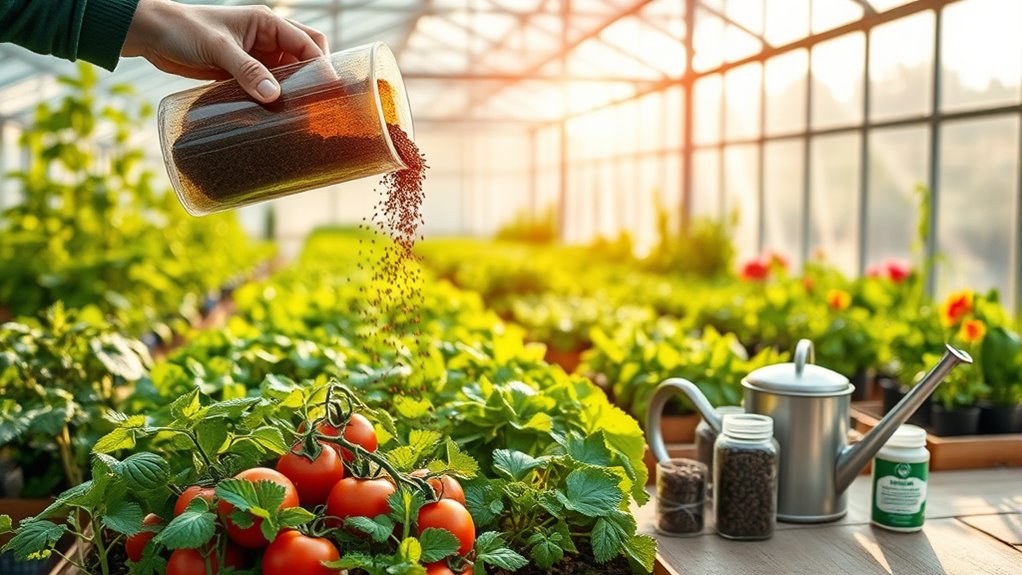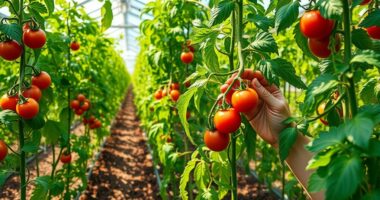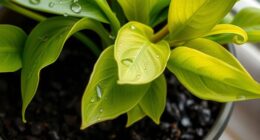To fertilize your greenhouse garden effectively, you need to understand your plants’ nutrient needs, choose the right fertilizer type—organic or synthetic—and time applications carefully to match growth stages. Regular soil tests help identify deficiencies and prevent excesses. Proper application, storage, and adjusting to seasonal changes guarantee healthy growth. If you want to master the best practices for lush, productive plants, there’s more to discover about maintaining soil health and avoiding common mistakes.
Key Takeaways
- Test soil pH and nutrient levels regularly to ensure optimal conditions for plant growth.
- Choose appropriate fertilizers (organic or synthetic) based on plant needs and environmental impact.
- Time fertilization to match plant growth stages, increasing during active growth and reducing during dormancy.
- Store fertilizers properly in cool, dry conditions to maintain effectiveness and prevent spoilage.
- Monitor plants for deficiency symptoms or over-fertilization signs to adjust fertilization practices accordingly.
Understanding Plant Nutrients and Their Roles

To grow healthy, vigorous plants in your greenhouse, understanding the essential nutrients they need is critical. Soil pH plays a pivotal role in nutrient absorption, affecting how well plants can access necessary elements. If the pH is too high or too low, it can lock out nutrients, leading to deficiencies. Regular testing can help identify soil imbalances before they affect plant health. Analyzing soil chemistry is essential for maintaining optimal conditions for plant growth. Micronutrient balance is equally important; even in small amounts, nutrients like iron, zinc, and manganese support essential plant functions. An imbalance can cause poor growth or symptoms like leaf discoloration. Ensuring proper micronutrient levels can prevent deficiencies that hinder plant development. Additionally, understanding nutrient deficiencies can help you diagnose and address specific plant health issues more effectively. Regularly testing your soil’s pH and micronutrient levels helps you maintain ideal conditions. Incorporating soil testing kits into your routine can provide more accurate insights into your soil’s health. When these factors are in harmony, your plants can efficiently absorb the nutrients they require, resulting in healthier, more productive growth in your greenhouse. Advances in automation technologies are also making it easier to monitor and manage these conditions precisely.
Choosing the Right Fertilizer Types for Your Greenhouse
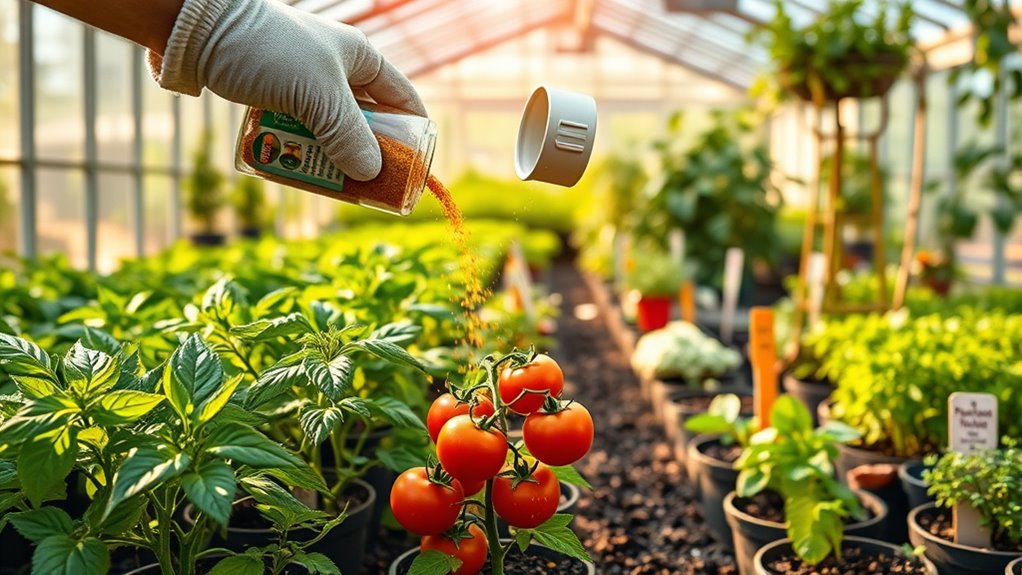
Selecting the appropriate fertilizer types is essential for ensuring your greenhouse plants receive the right nutrients at the right time. First, consider your soil pH, as it influences nutrient availability and determines whether you should choose acid-based or alkaline fertilizers.
For example, if your soil is acidic, you might opt for fertilizers that help balance pH levels. Also, think about fertilizer storage—choose options that are easy to handle and store safely, like liquid or soluble formulas, which minimize mess and deterioration. Regularly monitoring projector bulb maintenance can also help extend the lifespan of your equipment, ensuring your setup stays in top condition. Organic fertilizers like compost or fish emulsion can be great for sustainable growth, but they may require different storage conditions. By understanding your soil pH and properly managing fertilizer storage, you can select the best fertilizer type to promote healthy, vigorous plants in your greenhouse.
Timing Your Fertilizer Applications for Optimal Growth
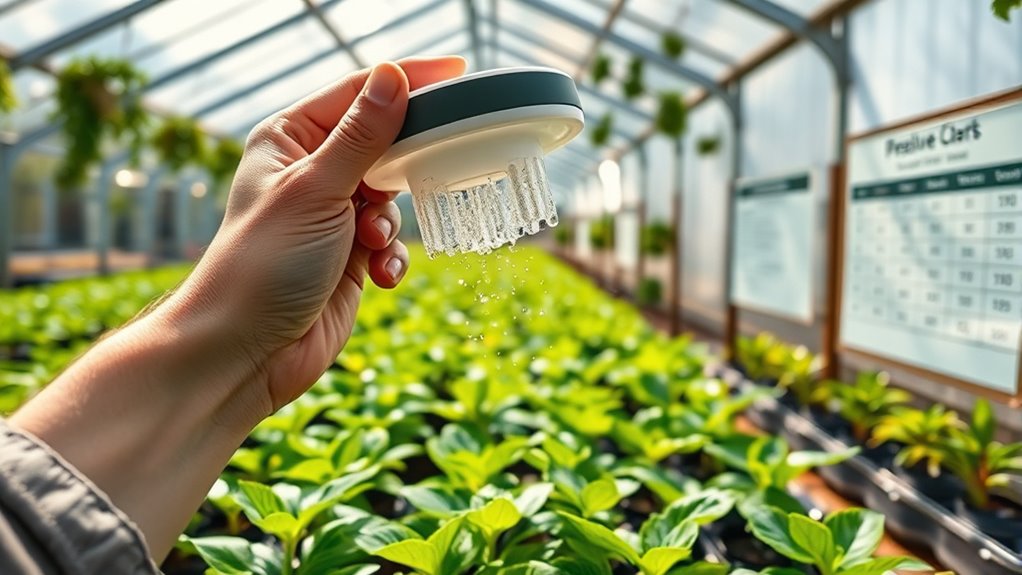
To get the best results, you need to time your fertilizer applications carefully throughout your plants’ growth stages. Applying nutrients at the right moments ensures healthy development and maximizes yields. Additionally, considering seasonal changes can help you adjust your fertilizing schedule for peak growth. Properly managing soil health is also crucial for maintaining nutrient availability and supporting vigorous plant growth.
Growth Stage Fertilization
When you synchronize fertilizer applications with your plants’ growth stages, you guarantee they receive nutrients exactly when they need them most. During the vegetative stage, focus on higher nitrogen levels to promote lush foliage. Proper pH adjustment is essential at each stage, ensuring nutrients are available and absorbed efficiently. This prevents deficiencies and promotes healthy growth. Furthermore, using vetted water-resistant fertilizers can help maintain nutrient levels even in humid or rainy conditions. Additionally, timely fertilization can help with pest control strategies by strengthening plant resilience. Incorporating effective storage solutions can also ensure your fertilizers remain effective and prevent waste or contamination. Regularly monitoring air quality can also contribute to creating a healthy environment for your greenhouse plants, promoting overall growth and vitality. Avoid over-fertilizing, which can cause nutrient imbalances and attract pests.
Seasonal Application Timing
Timing your fertilizer applications throughout the year is essential for maximizing plant health and yield in your greenhouse. Adjusting pH levels seasonally guarantees nutrients remain available, preventing deficiencies or toxicities. Incorporate vertical storage solutions to keep fertilizers organized and accessible, reducing waste and contamination. During active growth periods, apply fertilizer more frequently, but reduce frequency during dormancy or cooler months. Proper fertilizer storage is key—keep supplies in a cool, dry place to preserve effectiveness and prevent contamination. This prevents waste and ensures your fertilizer remains effective when needed. Recognizing regulatory compliance and seasonal needs of your plants, tailoring applications to their natural growth cycles, is crucial for optimal results. Additionally, understanding sound healing science can inspire innovative ways to create a calming environment that promotes plant growth and stress reduction. Implementing soil testing allows for precise adjustments to nutrient levels, improving fertilization efficiency. By syncing fertilization with seasonal changes, you promote ideal nutrient uptake, healthy development, and stronger yields year-round. Proper timing, pH adjustment, and fertilizer storage practices help you get the most from your fertilizer investments.
Organic vs. Synthetic Fertilizers: Pros and Cons

When choosing between organic and synthetic fertilizers, you should consider how each impacts the environment, with organics typically being more eco-friendly. You’ll also want to think about how quickly nutrients become available to your plants, as synthetics usually release them faster. Additionally, cost and accessibility can influence your decision, since synthetic options often cost less and are easier to find. Understanding nutrient release rates can help you better interpret plant care instructions and gardening advice.
Environmental Impact Differences
Organic and synthetic fertilizers differ considerably in their environmental impacts, influencing soil health, water quality, and ecosystem stability. Organic options typically improve soil structure and promote microbial activity, reducing pesticide interactions that can harm beneficial insects and soil life. They also tend to have a milder effect on soil pH, helping maintain natural acidity levels.
In contrast, synthetic fertilizers can cause nutrient runoff, contaminating nearby water sources, and may lead to soil degradation over time. Their concentrated nutrients can disrupt local ecosystems if not carefully managed. Additionally, synthetic fertilizers often have more immediate nutrient release but may contribute to imbalances in soil pH, affecting plant health and soil organisms.
Choosing the right type depends on your environmental priorities and the specific needs of your greenhouse garden.
Nutrient Release Rates
Understanding how quickly nutrients become available to your plants is essential for effective fertilization. Organic fertilizers typically release nutrients slowly, providing a steady supply over time, while synthetic options release nutrients rapidly, risking overfeeding. This difference affects your plant’s growth and pH balance, as quick nutrient release can alter soil acidity.
Proper fertilizer storage is crucial to prevent degradation, especially for organic products that may be sensitive to moisture and temperature. When choosing between the two, consider how you want nutrients delivered and your ability to monitor pH levels.
Keep in mind:
- Organic fertilizers release nutrients gradually
- Synthetic fertilizers act quickly
- pH balance can be affected by nutrient type
- Proper fertilizer storage prolongs efficacy
- Release rate impacts plant health and growth consistency
Cost and Accessibility
Choosing the right fertilizer often depends on your budget and how easily you can access supplies. Organic fertilizers tend to have higher cost considerations upfront but are often easier to find at local stores or through community sources.
Synthetic fertilizers usually cost less initially and are widely available, making them an accessible option for many growers. However, accessibility challenges can arise with organic options if specialty stores or farmers’ markets are limited in your area.
Consider your budget and the availability of supplies when deciding between organic and synthetic fertilizers. While organic options may require more effort to source, they often offer long-term soil health benefits.
Synthetic fertilizers, on the other hand, provide quick results but may be less sustainable over time.
How to Properly Apply Fertilizers in Your Greenhouse
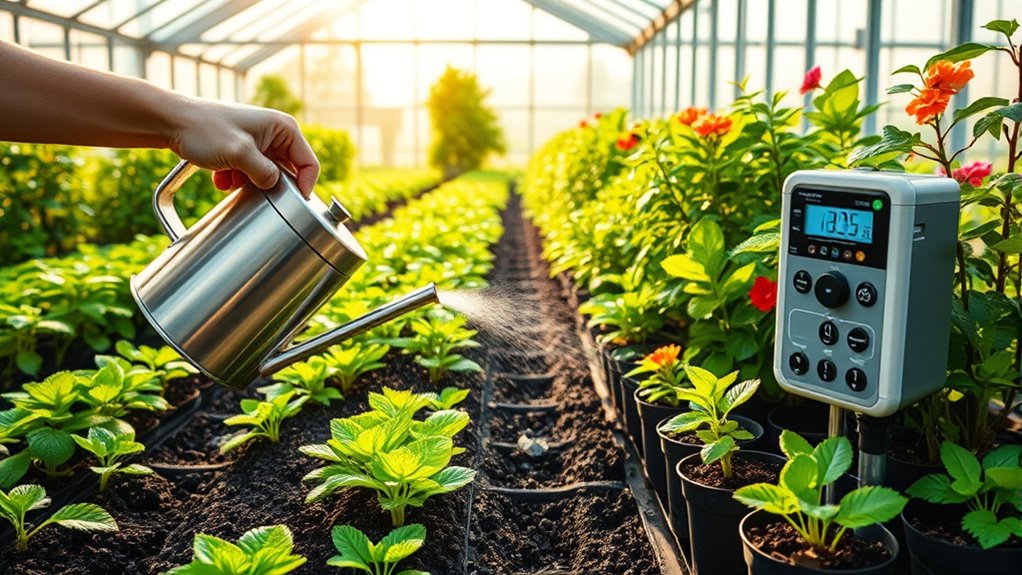
To guarantee your plants thrive, applying fertilizers correctly is essential. Proper application ensures nutrients reach your plants efficiently, promoting healthy growth. Always follow the manufacturer’s instructions for dosage and timing.
Use a consistent watering schedule to help fertilizers absorb evenly. Incorporate pest prevention measures to avoid damage that could hinder nutrient uptake.
When fertilizing, consider the type of fertilizer—liquid or granular—and apply accordingly. Avoid over-fertilizing, which can cause root burn or nutrient imbalance.
Regularly monitor your plants for signs of stress or deficiencies. Remember, consistency is key to maintaining healthy growth and preventing pest issues.
Properly timed and measured fertilizer applications help your greenhouse plants flourish, keeping them vibrant and productive throughout the season.
- Follow manufacturer instructions precisely
- Water before and after fertilizing
- Use appropriate fertilizer types
- Maintain consistent watering schedules
- Incorporate pest prevention strategies
Recognizing Signs of Nutrient Deficiency and Excess
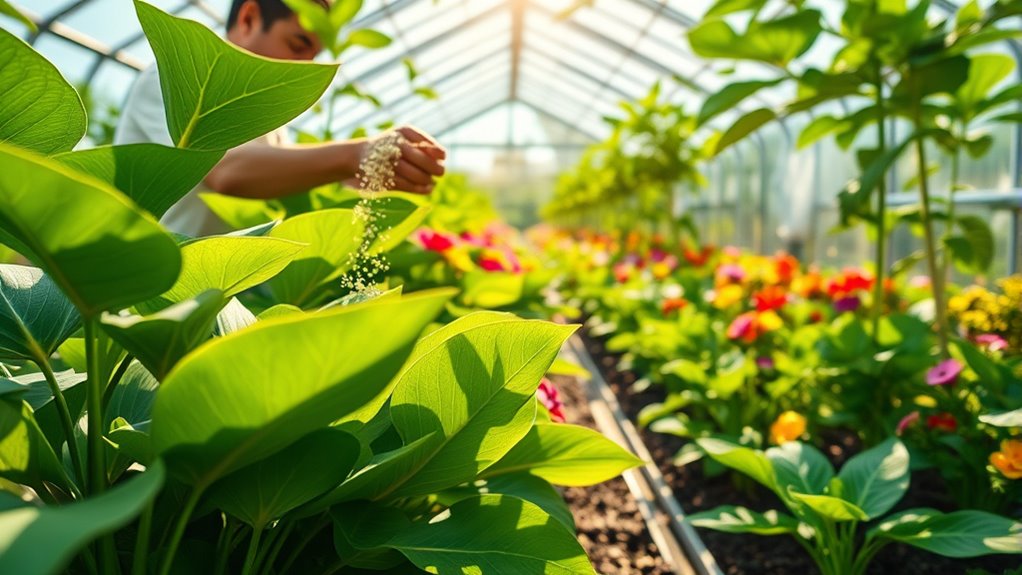
Recognizing the signs of nutrient deficiency and excess is essential for maintaining a healthy greenhouse garden. When plants show yellowing leaves or stunted growth, it may indicate a nutrient shortage or imbalance.
Check your soil pH, as an improper pH level can lock out nutrients, causing deficiencies even if fertilizers are applied.
Excess nutrients can lead to leaf burn or overly lush, weak growth, attracting pests and complicating pest control efforts.
Keep an eye on leaf coloration, spotting browning tips or mottling, which signal excess or deficiency.
Regular soil testing helps you catch issues early.
Adjust your fertilization and pH levels accordingly to prevent deficiencies and excesses, ensuring your plants remain vibrant and healthy without inviting pest problems.
Adjusting Fertilizer Regimens for Different Plant Species
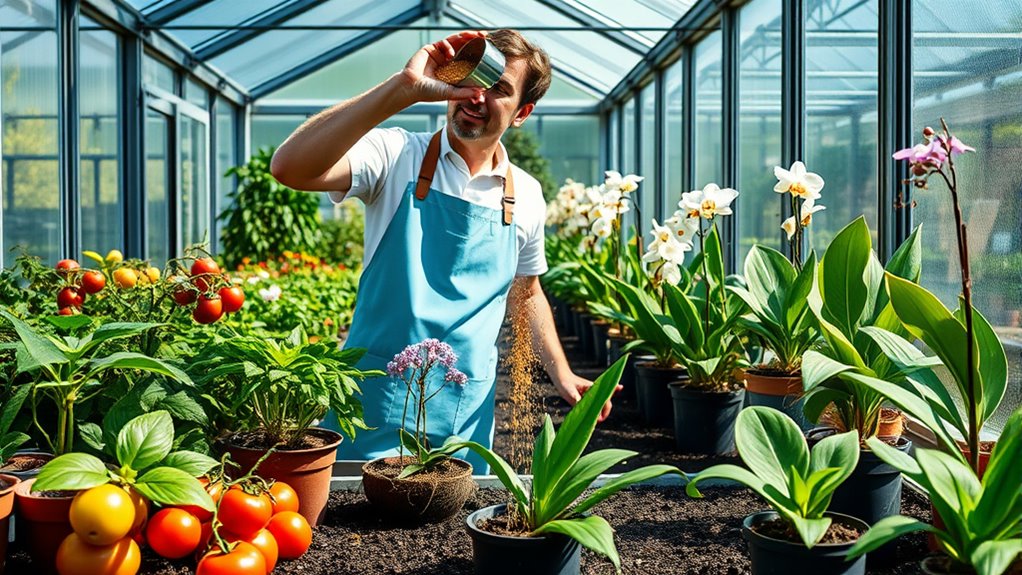
Different plant species have unique nutritional needs that require tailored fertilization strategies. Understanding their nutrient preferences helps you optimize growth and health.
For example, leafy greens often need higher nitrogen levels, while flowering plants may require more phosphorus. Adjust your fertilizer regimen accordingly to meet these specific demands.
Keep in mind that not all plant species respond the same way to fertilizers, so monitoring their growth is essential. You can also experiment with different formulations to find what works best for each type.
Remember, a one-size-fits-all approach can lead to deficiencies or excesses. To help you customize your fertilization plan, consider these key points:
- Recognize each plant’s nutrient preferences
- Use specialized fertilizers for different species
- Adjust feeding frequency based on growth stage
- Observe plant responses regularly
- Avoid over-fertilizing to prevent damage
Common Mistakes to Avoid When Fertilizing
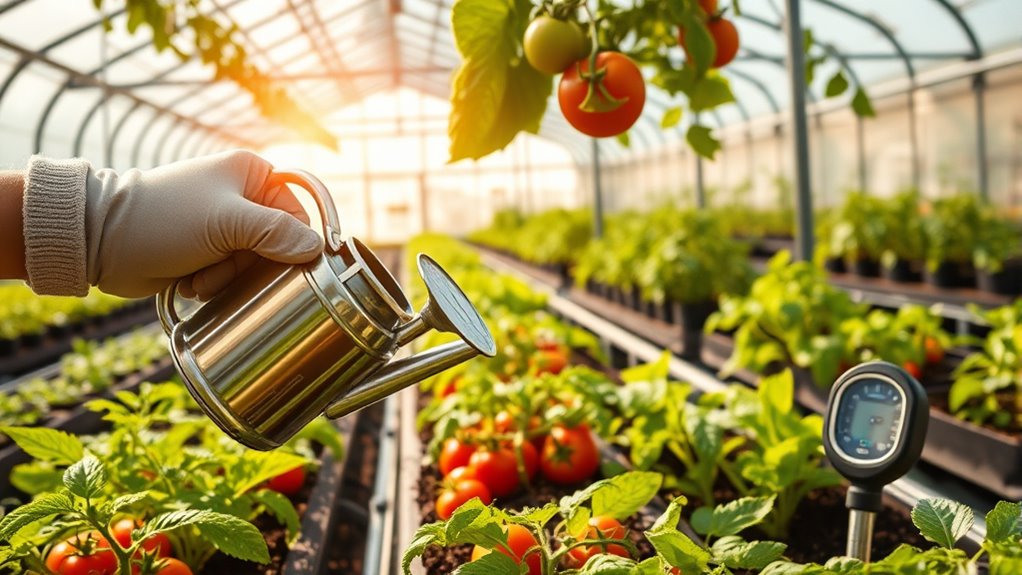
Fertilizing mistakes can easily harm your greenhouse plants if you’re not careful. Over-fertilizing can lead to nutrient buildup, which may weaken plants and attract pests, complicating pest management efforts.
Under-fertilizing, on the other hand, results in poor growth and weak plants. Avoid applying fertilizer on a strict schedule without considering your plants’ specific needs.
Additionally, poor greenhouse ventilation can cause humidity to rise, fostering fungal issues that fertilizer application might worsen. Proper airflow helps reduce excess humidity and prevents pest infestations that can be triggered by stressed plants.
Monitoring and Maintaining Soil Health Over Time
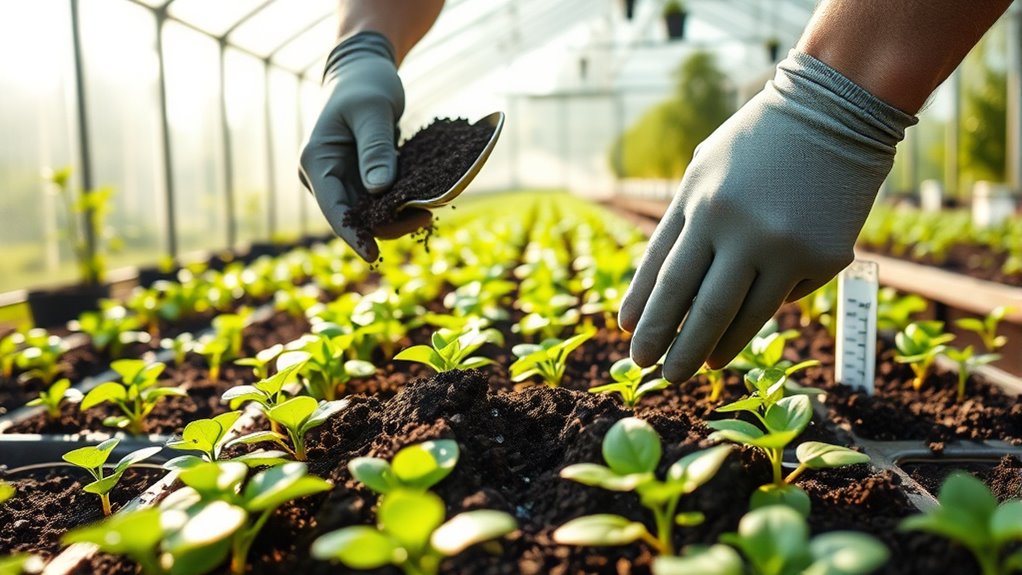
To keep your greenhouse plants healthy over time, regularly monitoring and maintaining soil health is essential. Soil testing helps you track nutrient levels and pH, ensuring ideal conditions. Focus on microbial health, as beneficial microbes improve nutrient availability and suppress diseases.
Regularly adding organic matter boosts microbial activity and soil structure. Avoid over-fertilizing, which can harm soil balance and microbial life. Keep an eye on drainage and aeration to prevent compaction and promote healthy roots.
Consistent testing and adjustments help maintain a thriving soil environment that supports plant growth.
- Conduct soil tests at least twice a year
- Incorporate compost or organic amendments
- Avoid synthetic fertilizers that harm microbes
- Rotate crops to prevent nutrient depletion
- Use cover crops to protect and enrich soil
Frequently Asked Questions
How Often Should I Fertilize My Greenhouse Plants?
You should fertilize your greenhouse plants based on their specific needs and growth stages. Typically, a regular fertilizer application schedule involves feeding plants every one to two weeks.
However, adjust the frequency if you notice signs of plant nutrient deficiencies. Keep an eye on your plants’ health and growth, and modify your schedule accordingly to guarantee they get the right nutrients without overdoing it.
This helps maintain healthy, vigorous plants.
Can Over-Fertilizing Harm My Plants?
Yes, over-fertilizing can harm your plants. It disrupts the plant nutrient balance, leading to issues like root damage or nutrient burn.
When you use too much fertilizer, you risk fertilizer overuse, which can cause leaf scorch, stunted growth, or even plant death.
To avoid these risks, follow recommended fertilization guidelines and monitor your plants for signs of excess nutrients, ensuring they stay healthy and thrive.
Are There Specific Fertilizers for Flowering vs. Leafy Plants?
You’ll find that specific fertilizers suit flowering plants and leafy ones differently because of their unique plant nutrient ratios. Flowering plants need fertilizers with higher phosphorus, while leafy plants thrive with more nitrogen.
Pay attention to fertilizer application timing, as applying the right nutrients at the right growth stage guarantees results.
Using tailored fertilizers ensures healthy blooms or lush foliage, helping your plants flourish in your greenhouse.
How Do I Test My Soil’S Nutrient Levels Accurately?
Imagine uncovering hidden clues in your soil—testing reveals what’s really going on beneath. To do this, you need a reliable soil pH testing kit, which helps you determine acidity or alkalinity.
Watch for nutrient deficiency signs like yellowing leaves or stunted growth. Accurate testing guides your fertilizing plan, ensuring you provide just what your plants need.
Don’t leave it to guesswork—precision now leads to a thriving greenhouse garden.
What Natural Alternatives Exist for Chemical Fertilizers?
You can explore natural alternatives to chemical fertilizers through organic composting and homemade fertilizer recipes. Composting kitchen scraps and yard waste creates nutrient-rich soil that boosts plant growth.
You might also try simple recipes like banana peel tea or fish emulsion, which supply essential nutrients naturally. These methods improve soil health, reduce chemical reliance, and are eco-friendly options that support a thriving greenhouse garden.
Conclusion
By mastering proper fertilization, you’re nurturing a vibrant, thriving greenhouse oasis—each plant a brushstroke in your lush garden masterpiece. Remember, your hands hold the power to unfasten nature’s bounty, guiding roots to drink deeply and leaves to flourish like a symphony of life. Stay attentive to your plants’ needs, adjust with care, and watch your greenhouse bloom into a breathtaking sanctuary where growth and beauty flourish in harmony.
